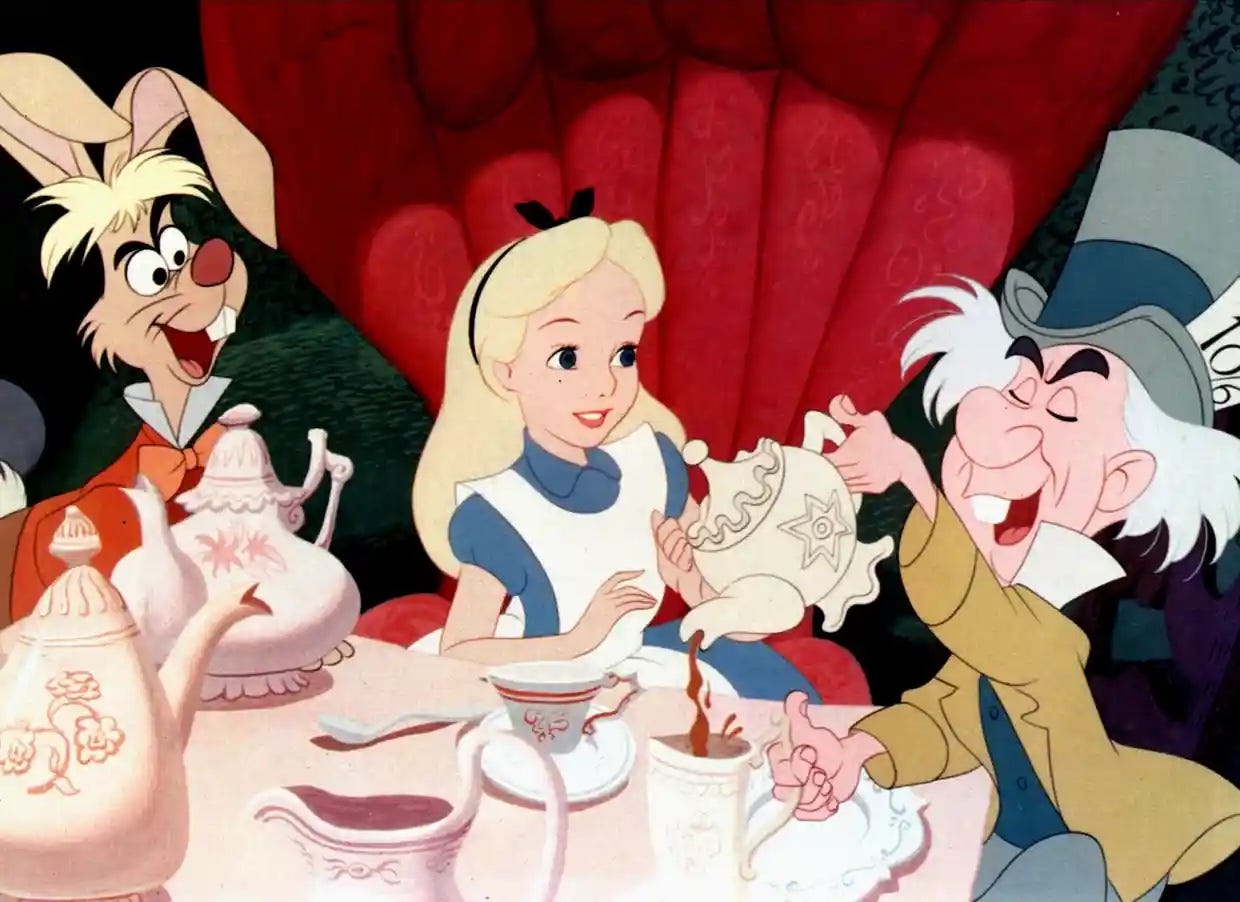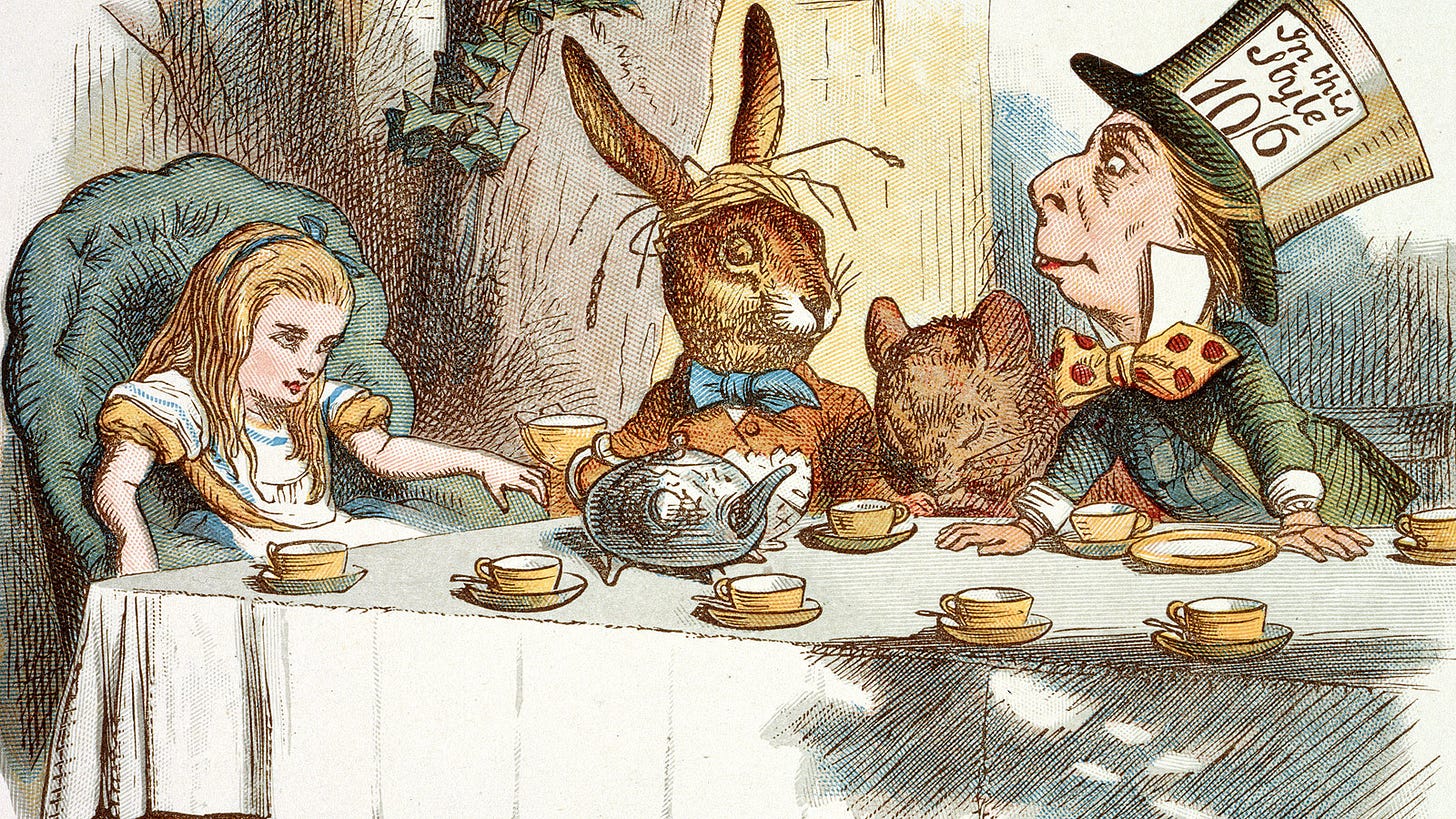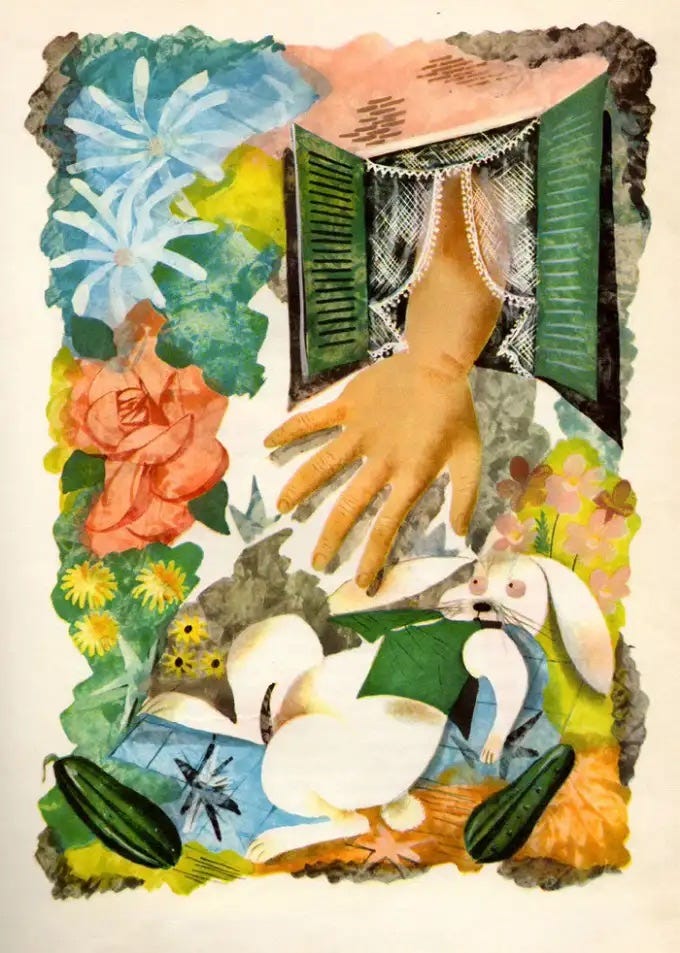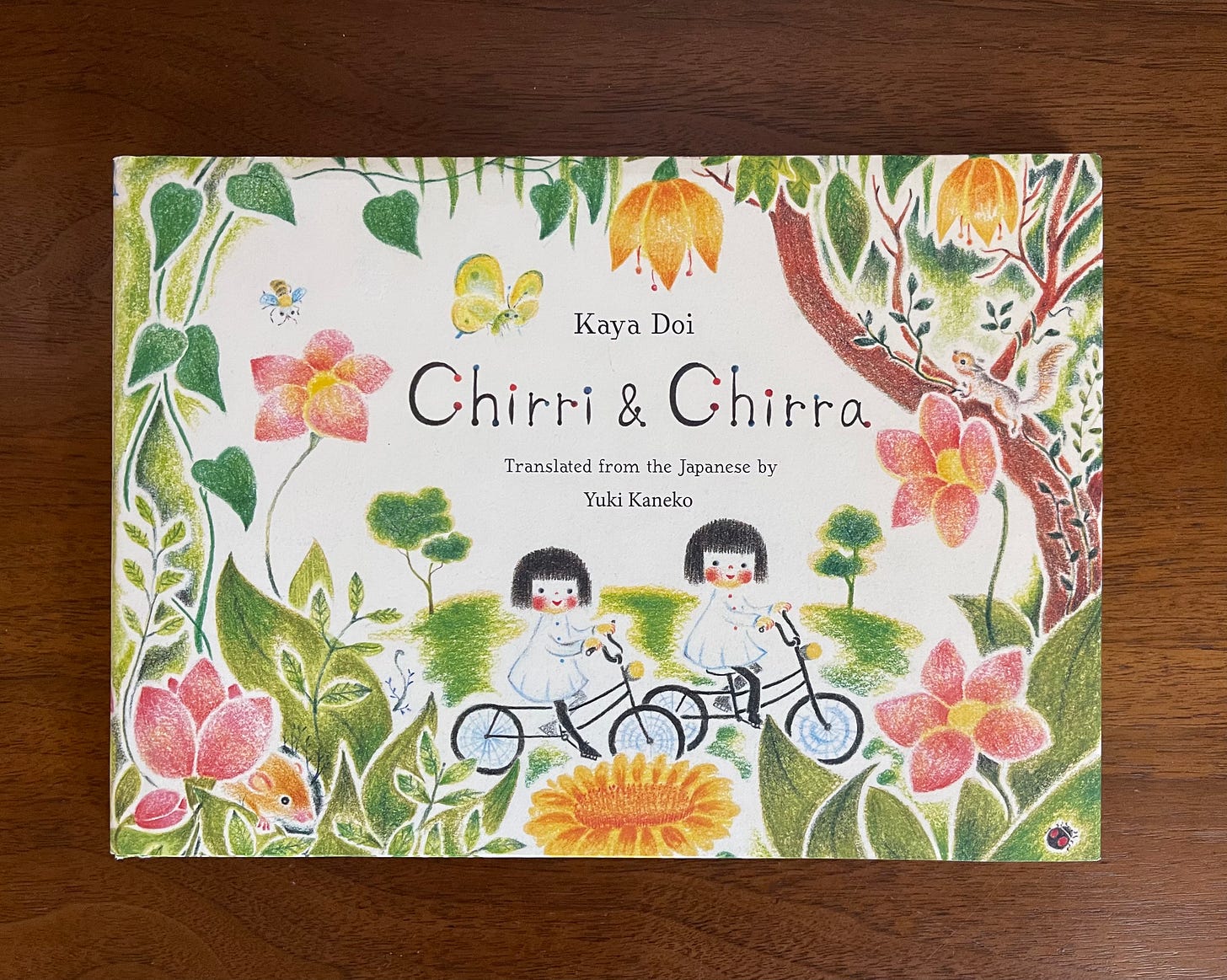Curiouser & Curiouser!
The delightfully weird and wonderful worlds of "Chirri and Chirra" and "Alice in Wonderland."
Disclaimer: This is a picture-heavy newsletter. If you’re reading it in Gmail and see three gray dots while scrolling, please click them to see more. Thanks!
I grew up an only child, or at least it felt that way sometimes. My sister is twelve years older than me, and by the time I was six, she was eighteen—an adult! Now that we’re both adults, I hardly notice our age difference, but I felt it acutely as a child. Without a sibling to play with, much of my time was spent alone in my room, acting out imaginary stories. Sometimes I was a queen; other times, a mermaid, but usually, I was just myself: a young girl trying to figure out how the world worked and who she was by playing make-believe.
Those long, solitary hours often led me to books and films. And while I struggle to remember the books I read as a little girl, I do remember the movies. One of my first favorites was Walt Disney’s Alice in Wonderland (1951). I knew the film by heart. I even had an Alice in Wonderland-themed party for my fourth birthday. But I had no clue there was a book. It wasn’t until I was an adult that I finally read Lewis Carroll’s Alice’s Adventures in Wonderland (1865) and Through the Looking-Glass and What Alice Found There (1871).
Walt Disney’s “Alice in Wonderland” tea party (1951)
I can’t help but notice the parallels to my own life: a bored and curious little girl dreams up a world of her own, a world where everything is complete nonsense. Like Alice, I was very inquisitive (I still am!). I looked to my dream world to explain things about the real world, things that adults sheltered from me. It didn’t really make much sense—the mingling of these two mysterious worlds often left me more confused. But I liked exploring the unknown, even if it felt scary (I still do!). Although, sometimes, my overactive imagination got me into trouble: falling down a rabbit hole while chasing a figment of my imagination feels like a metaphor for my life.
A colorized version of The Mad Hatter’s Tea Party from Alice’s Adventures in Wonderland (1865) illustrated by John Tenniel (1865)
Charles Dodgson (Lewis Carroll is his pen name) first told this story out loud on a warm summer day in 1856. He was in a row boat with his friend Robinson Duckworth and three of the Liddell sisters, one of whom was named Alice. Bored, the young girls asked Dodgson to tell them a story, and he improvised the broad strokes of the tale right on the spot. The real Alice was so delighted she asked him to write his story down. He obliged, added more details and rough illustrations, and called it Alice’s Adventures Underground. Dodgson later showed the story to friends, who encouraged him to take it to a publisher. And in 1865, Macmillan published Alice’s Adventures in Wonderland.
Like fairy tales, Alice in Wonderland started through oral storytelling, and throughout the past 157 years, it’s been reinterpreted in thousands of ways. However, unlike most fairy tales, this story doesn’t have a moral. Dodgson was against moralistic stories for children, despite his staunchly religious background. He wasn’t interested in teaching a lesson; he wanted this story to feel open and fun. As a result, people tend to project whatever meaning they want onto it. But that perplexing, playful mixture of sophisticated nonsense is a big part of the story’s appeal (it’s why I’m continually drawn to it). No one knows what it’s about—it’s not particularly about anything—yet it’s immensely enjoyable.
Alice’s Adventures in Wonderland and Through the Looking Glass (1949) by Leonard Weisgard
Alice in Wonderland concept art for Disney by Mary Blair
Since Carroll, many authors have written stories where children discover portals to fantastical worlds. In C.S. Lewis’s The Chronicles of Narnia series (1950-1956), Lucy and her siblings discover a pathway to a magical universe through a wardrobe. In Neil Gaiman’s Coraline (2002), a young girl is transported to an idealized but eerie parallel world through a brick wall in her father’s drawing room. But it wasn’t until I discovered the Japanese picture book series Chirri and Chirra that I experienced the same hypnotic delight that I did with Alice in Wonderland.
Chirri and Chirra (2016)
Chirri and Chirra is a beloved series in Japan written and illustrated by Kaya Doi, but thanks to the wonderful translations by the independent publisher Enchanted Lion Books, they’ve recently gained attention in The States. In the first book, Chirri and Chirra (published in Japan in 2005 and in the US in 2016), we’re introduced to two identical little girls who embark on a whimsical adventure through the natural world. There is no portal, no magical transportive door; all we know is that they’ve somehow arrived in a fantastical forest on their matching bicycles. They discover a forest café and are greeted by a kindly fox and two adorable honeybees who are drinking sweet violet tea. Next, they pedal along through the forest and come upon a bakery; they order strawberry jam sandwiches on walnut bread and soy rolls with chestnut jam and sit by a nearby pond to enjoy their mouthwatering lunches. The story is almost about nothing: the girls eat delicious food, play in the water, and take a nap under a big tree. The meandering journey through the imaginations of these two girls is gently told—and yet, somehow, it’s an immersive experience that’s immediate and intoxicating.
Chirri and Chirra (2016)
Chirri and Chirra, In the Tall Grass (2017)
Chirri and Chirra, The Rainy Day (2021)
Chirri and Chirra, Under the Sea (2020)
Throughout the books, Chirri and Chirra experience new wonders while riding their bicycles. Each story begins, Dring-dring, dring-dring, as they pedal through tall grass, under the sea, and through rain clouds. The sound of their bikes and the sound of their names, Chirri-Chirra, Chirri-Chirra, echo one another in parallel worlds. Doi’s repetitive use of onomatopoeia is the transportive element that takes us from real to imaginary. And her softly drawn illustrations in beautiful pastels, colored pencils, and crayons are meditative in their creamy, dreamlike quality. But it’s the delicate descriptions of food that I find most nourishing. There are honey sponge cake balls wrapped in flower petals, chrysanthemum tea with lemon marmalade, sea-spray parfait à la conch, and marine soda jelly topped with pearl cream. Reading these books out loud sends a tingling feeling down the back of your neck, eliciting an ASMR-induced balmy euphoria.
Chirri and Chirra, In the Night (2022)
The latest book, Chirri and Chirra, In the Night (2022), is my favorite so far. The girls set off on a nighttime adventure with the help of their trusty bicycles (this time with headlights) and the glorious light of the full moon. Along the way, they befriend two cats who serve them fizzy full-moon drinks that transform them into adorable girl cats with pointy ears and long tails, allowing them to see clearly in the dark. They also receive sparkling flower necklaces that grant them access to a fancy night market where they joyfully parade through the moonlit forest with their new animal acquaintances.
Both Chirri and Chirra and Alice in Wonderland pay tribute to idle reverie and the creative imagination of children. Carroll’s approach is wild, strange, and ridiculous, whereas Doi’s is gentle, soothing, and meditative. But both validate the intelligence of children, and both incorporate playful language to propel readers deeper into their fantasy worlds. Doi’s books would still be delightful without the words, but the books truly sing when read aloud. And Carroll’s linguistic acrobatics send us on a fun and discombobulating adventure through Wonderland.
Surely Doi was influenced by Carroll, as so many children’s book authors and illustrators are, but what’s impressive about her unique interpretation is its subtlety. Even in Chirri and Chirra, Underground (2019)—perhaps her closest resemblance to Alice in Wonderland —she remains soft rather than subversive. The incantatory nature of her books, through their structure, language, and artwork, is dreamy and comforting. She transports us to that hazy liminal space between reality and fantasy without any explanation, lessons, or sentimentality. Every time Chirri and Chirra set off on their bicycles, they discover something strange, wonderful, and new, a “curiouser and curiouser!” adventure!
Moonbow is a reader-supported publication. It exists because of the support of generous readers like you! If you enjoy Moonbow, the best ways you can support it is to subscribe, share this newsletter with a friend, and consider upgrading to a paid subscription. Thanks for reading!
Big thanks to Enchanted Lion Books for sending me many of the Chirri and Chirra books for this article. Enchanted Lion Books is an independent publisher out of Brooklyn, NY, that makes beautiful, thoughtful, and experimental picture books. Their books Telling Stories Wrong (2022) and The Little One (2021) made my list of The Best Books I Read This Year! And they’re launching Unruly—a new imprint that expands the picture book genre with illustrated titles created for middle grade, teenage, and adult readers. You can learn more about it and support them on Kickstarter!

















Alice is a big hit here and so are Chirri and Chirra! I hadn’t considered the parallels between the two .. the beauty of the chirri and chirra books for us is in their journey not necessarily their destination .., which is sort of what I take from Alice too!
Same boat here -- my siblings are 12 and 11 years older than I am and have a different mother so didn't live with me, so I was functionally an only child. I was also deeply in love with Alice in Wonderland (the movie) as a child.
You've done a beautiful job comparing Alice (the book) to the Chirri and Chirra series -- I've never thought of the parallels before! And those books are just so dreamy, lovely, and amazing.